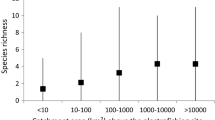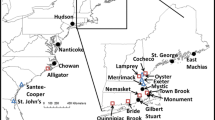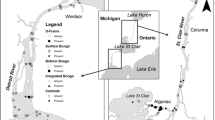Abstract
Alteration of flow regimes by anthropogenic activities is one of the primary environmental problems in riverine systems. Understanding how hydrologic conditions can affect ontogenetic habitat shifts of imperiled fishes is important in order to develop conservation and management strategies for each life-history stage. We examined relationships between the abundance of young-of-the-year (YOY) Rio Grande Blue Sucker and various abiotic variables in the Trans-Pecos region of the Rio Grande in Texas, USA. We used open N-mixture modeling to better understand the factors affecting ontogenetic habitat shifts of the imperiled aridland river fish. In addition, we examined differences in Rio Grande Blue Sucker total length among three mesohabitat types (pool, riffle, and run). The results of open N-mixture modeling suggested that as pool area increased, the abundance of YOY Rio Grande Blue Sucker increased. Total length of YOY Rio Grande Blue Sucker also significantly differed among the three mesohabitat types. The total lengths of YOY Rio Grande Blue Sucker in pool habitats were lower than in other mesohabitats, suggesting that YOY Rio Grande Blue Sucker undergo ontogenetic habitat shifts into greater current velocity habitats as they grow. The habitat associations we documented support the growing body of research emphasizing the importance of maintaining sufficient and appropriately timed flows to avoid prolonged low flows that limit habitat availability for native fish species during sensitive life stages in the Rio Grande and other aridland rivers.




Similar content being viewed by others
References
Acre MR (2019) Assessing demography, habitat use, and flow regime effects on spawning migrations of blue sucker in the lower Colorado River, Texas. Dissertation, Texas Tech University
Adams SR, Flinn MB, Burr BM, Whiles MR, Garvey JE (2006) Ecology of larval blue sucker (Cycleptus elongatus) in the Mississippi River. Ecol Freshw Fish 15:291–300
American Rivers (1993) The nation’s ten most endangered rivers and fifteen most threatened rivers for 1993. American Rivers, Washington, D.C
Archdeacon TP (2016) Reduction in spring flow threatens Rio Grande silvery minnow: trends in abundance during river intermittency. T Am Fish Soct 145:754–765
Arthington AH, Balcombe SR (2011) Extreme flow variability and the ‘boom and bust’ ecology of fish in arid-zone floodplain rivers: a case history with implications for environmental flows, conservation and management. Ecohydrology 4:708–720
Bayley PB, Herendeen RA (2000) The efficiency of a seine net. T Am Fish Soct 129:901–923
Bessert ML (2006) Molecular systematics and population structure in the north American endemic fish genus Cycleptus (Teleostei: Catostomidae). Dissertation, University of Nebraska
Bestgen KR, Platania SP (1988) The ichthyofauna and aquatic habitats of the Rio Grande from the new Mexico-Texas border to big bend National Park. United States Fish and Wildlife Service, Albuquerque
Biowest, Inc (2011) Lower Sabine River fishery study, downstream fisheries resources report. Report to the Sabine River Authority. http://www.tbpjo.org/PublicRelicensing/documents/TB_DLA/TBend%20Final%20Sabine%20FisheriesRsrcsRpt-110413.pdf. Accessed 21 March 2020
Blythe DE (2018) Assessing the ecological implications of the altered flow and sediment regimes of the Rio Grande along the West Texas-Mexico border. M.S. Thesis, Utah State University
Burr BM, Mayden RL (1999) A new species of Cycleptus (Cypriniformes: Catostomidae) from gulf slope drainages of Alabama, Mississippi, and Louisiana, with a review of the distribution, biology, and conservation status of the genus. Bull Ala Mus Nat Hist 20:19–57
Buth DG, Mayden RL (2001) Allozymic and isozymic evidence for polytypy in north American catostomid genus Cycleptus. Copeia 4:899–906
Calamusso B, Rinne JN, Edwards RJ (2005) Historic changes in the Rio Grande fish fauna: status, threats, and management of native species. In: Rinne JN, Hughes RM, Calamusso B (ed) historical changes in large river fish assemblages of the Americas. American fisheries society, symposium 45, Maryland, pp 205–223
Collins JP, Young C, Howell J, Minckley WL (1981) Impact of flooding in a Sonoran Desert system, including elimination of an endangered fish population (Poeciliopsis o. occidentalis, Poeciliidae). Southwest Nat 26:415–423
Cooke SJ, Paukert C, Hogan Z (2012) Endangered river fish: factors hindering conservation and restoration. Endanger Species Res 17:179–191
Dail D, Madsen L (2011) Models for estimating abundance from repeated counts of an open metapopulation. Biometrics 67:577–587
Dean DJ, Schmidt JC (2011) The role of feedback mechanisms in historic channel changes of the lower Rio Grande in the big bend region. Geomorphology 126:333–349
Dettinger M, Udall B, Georgakakos A (2015) Western water and climate change. Ecol Appl 25:2069–2093
Dombrosky J, Wolverton S, Nagaoka L (2016) Archaeological data suggest broader early historic distribution for blue sucker (Cycleptus elongatus, Actinopterygii, Catostomidae) in New Mexico. Hydrobiologia 771:255–263
Dudley RK, Platania SP (2007) Flow regulation and fragmentation imperil pelagic-spawning riverine fishes. Ecol Appl 17:2074–2086
Eder BL (2009) Use of constructed side channels of the Missouri River (Nebraska) by age-0 blue sucker (Cycleptus elongatus). J Freshw Ecol 24:667–668
Everitt B (1993) Channel responses to declining flow on the Rio Grande between Ft. Quitman and presidio, Texas. Geomorphology 6:225–242
Fiske I, Chandler R, Miller D, Royle A, Kery M, Hostetler J, Hutchinson R (2017) Models for data from unmarked animals. R package version 0.12–2
George SD, Pinion AK, Conway KW, Heard TC, Perkin JS (2019) Observations on habitat use of age-0 Rio Grande blue sucker (Cycleptus sp. cf. elongatus). West N Am Naturalist 79:463–469
Heard TC, Perkin JS, Bonner TH (2012) Intra-annual variation in fish communities and habitat associations in a Chihuahua Desert reach of the Rio Grande/Rio Bravo Del Norte. West N Am Naturalist 72:1–15
Houde ED (2002) Mortality. Page 64–84. L. a. Fuiman and R. G. Werner, editors. Fishery science: the unique contributions of early life stages. Wiley-Blackwell, Hoboken
Hubbs C, Edwards RJ, Garrett GP (2008) An annotated checklist of the freshwater fishes of Texas, with keys to identification of species. Texas Academy of Science, Austin
Hubbs C, Wauer R (1973) Seasonal changes in the fish fauna of Tornillo Creek, Brewster County, Texas. Southwest Nat 17:375–379
Jelks HL, Walsh SJ, Burkhead NM, Conteras-Balderas S, Diaz-Pardo E, Hendrickson DA, Lyons J, Mandrak NE, McCormick F, Nelson JS, Platania SP, Porter BA, Renaud CB, Schmitter-Soto JJ, Taylor EB, Warren ML Jr (2008) Conservation status of imperiled north American freshwater and diadromous fishes. Fisheries 33:372–407
Lozano-Vilano ML (2010) Recent record of Cycleptus in the Rio Conchos, Chihuahua, Mexico. Southwest Nat 55:284–286
Markle DF, Clauson K (2006) Ontogenetic and habitat-related changes in diet of late larval and juvenile suckers (Catostomidae) in upper Klamath Lake, Oregon. West N Am Naturalist 66:492–501
Mayes KB (2015) Blue sucker movement and habitat use in the lower Sabine River, Texas. Report to the Texas Water Development Board (contract no. 1004831019). Texas parks and wildlife, river studies, inland fisheries: San Marcos, Texas
Minckley WL, Meffe GK (1987) Differential selection by flooding in stream-fish communities of the arid American southwest. In: Matthews WJ, Heins DC (eds) Community and evolutionary ecology of north American stream fishes. University of Oklahoma Press, Oklahoma, pp 93–104
Miyazono S, Taylor CM (2013) Effects of habitat size and isolation on species immigration-extinction dynamics and community nestedness in a desert river system. Freshw Biol 58:1303–1312
Miyazono S, Patiño R, Taylor CM (2015) Desertification, salinization, and biotic homogenization in a dryland river ecosystem. Sci Total Environ 511:444–453
Moss RE, Scanlan JW, Anderson CS (1983) Observations on the natural history of the blue sucker (Cycleptus elongatus Le Sueur) in the Neosho River. Am Midl Nat 109:15–22
Neumann RM, Allen MS (2007) Size structure. In: Guy CS, Brown ML (eds) Analysis and interpretation of freshwater fisheries data. American Fisheries Society, Maryland, pp 375–421
Peterson RC, Jennings CA (2007) Effects of river discharge on abundance and instantaneous growth of age-0 carpsuckers in the Oconee River, Georgia, USA. River Res Appl 23:1016–1025
Poff NL, Allan JD, Bain MB, Karr JR, Prestegaard KL, Richter BD, Sparks RE, Stromberg JC (1997) The natural flow regime: a paradigm for river conservation and restoration. BioScience 47:769–784
Pollock KH (1982) A capture–recapture design robust to unequal probability of capture. J Wildlife Manage 46:757–760
R Core Team (2018) R: a language and environment for statistical computing. R Foundation for Statistical Computing, Vienna
Rolls RJ, Leigh C, Sheldon F (2012) Mechanistic effects of low-flow hydrology on riverine ecosystems: ecological principles and consequences of alteration. Freshw Sci 31(4):1163–1186
Royle JA (2004) N-mixture models for estimating population size from spatially replicated counts. Biometrics 60:108–115
Rupprecht RJ, Jahn LA (1980) Biological notes on blue suckers in the Mississippi River. T Am Fish Soct 109:323–326
Schmidt JC, Everitt BL, Richard GA (2003) Hydrology and geomorphology of the Rio Grande and implications for river restoration. In: Garrett GP, Allan NL (ed) Aquatic fauna of the northern Chihuahuan Desert. University Special Publications Number 46, Museum of Texas Tech University, Texas, pp 25–42
Small MF, Bonner TH, Baccus JT (2009) Hydrologic alteration of the lower Rio Grande terminus: a quantitative assessment. River Res Appl 25:241–252
Stefferud JA, Gido KB, Propst DL (2011) Spatially variable response of native fish assemblages to discharge, predators and habitat characteristics in an arid-land river. Freshw Biol 56:1403–1416
Taylor CM (1997) Fish species richness and incidence patterns in isolated and connected stream pools: effects of pool volume and spatial position. Oecologia 110:560–566
Zipkin EF, Thorson JT, See K, Lynch HJ, Grant EH, Kanno Y, Chandler RB, Letcher BH, Royle JA (2014) Modeling structured population dynamics using data from unmarked individuals. Ecology 95:22–29
Zymonas ND, Propst DL (2007) Ecology of blue sucker and gray Redhorse in the lower Pecos River, New Mexico. New Mexico Department of Game and Fish, Santa Fe
Acknowledgments
We thank C. Starks, S. Stanfield, and S. Chandler for their assistance with field data collection and laboratory work. We also thank M. Acre, C. Alejandrez, M. Bean, J. Botros, L. Brown, D. Buckmeier, D. Chilleri, S. Curtis, J. East, D. Geeslin, S. Hill, M. Jackson, K. Kolodziejcyk, T. Lane, S Magnelia, K. Mayes, S. Pavlicek, A. Pinion, A. Nobles, D. Raleigh, E. Roesler, N. Smith, S. Soto, A. Stevens, and J. Webb for their assistance with field data collection. We thank P. Bean for his useful advice on Rio Grande Blue Sucker sampling. We also thank J. Perkin and C. Taylor for helpful reviews. This project was supported by Texas Parks and Wildlife Department. Partial funding for this project was through the Texas State Wildlife Grants program grant T-136-1 in cooperation with the U.S. Fish and Wildlife Service, Wildlife and Sport Fish Restoration Program. This project was conducted under Texas Tech University Animal Care and Use Committee (AUP#: 15080-12). The Texas Cooperative Fish and Wildlife Unit is jointly sponsored by U.S. Geological Survey, Texas Tech University, Texas Parks and Wildlife Department, Wildlife Management Institute, and U.S. Fish and Wildlife Service. The Hawai‘i Cooperative Fishery Research Unit is jointly sponsored by U.S. Geological Survey, the University of Hawai‘i System, Hawai‘i Department of Land and Natural Resources, and U.S. Fish and Wildlife Service. Any use of trade, firm, or product names is for descriptive purposes only and does not imply endorsement by the U.S. Government.
Author information
Authors and Affiliations
Corresponding author
Ethics declarations
Conflict of interest
The authors declare that they have no conflict of interest.
Human participants and/or animals
Field collection of fish was conducted under Texas Tech University Animal Care and Use Committee (AUP#: 15080–12). This article does not contain any studies with human participants.
Additional information
Publisher’s note
Springer Nature remains neutral with regard to jurisdictional claims in published maps and institutional affiliations.
Rights and permissions
About this article
Cite this article
Miyazono, S., Pease, A.A., Fritts, S. et al. Ontogenetic shifts in mesohabitat use of young-of-year Rio Grande blue sucker in the big bend region of the Rio Grande. Environ Biol Fish 103, 1471–1480 (2020). https://doi.org/10.1007/s10641-020-01038-8
Received:
Accepted:
Published:
Issue Date:
DOI: https://doi.org/10.1007/s10641-020-01038-8




